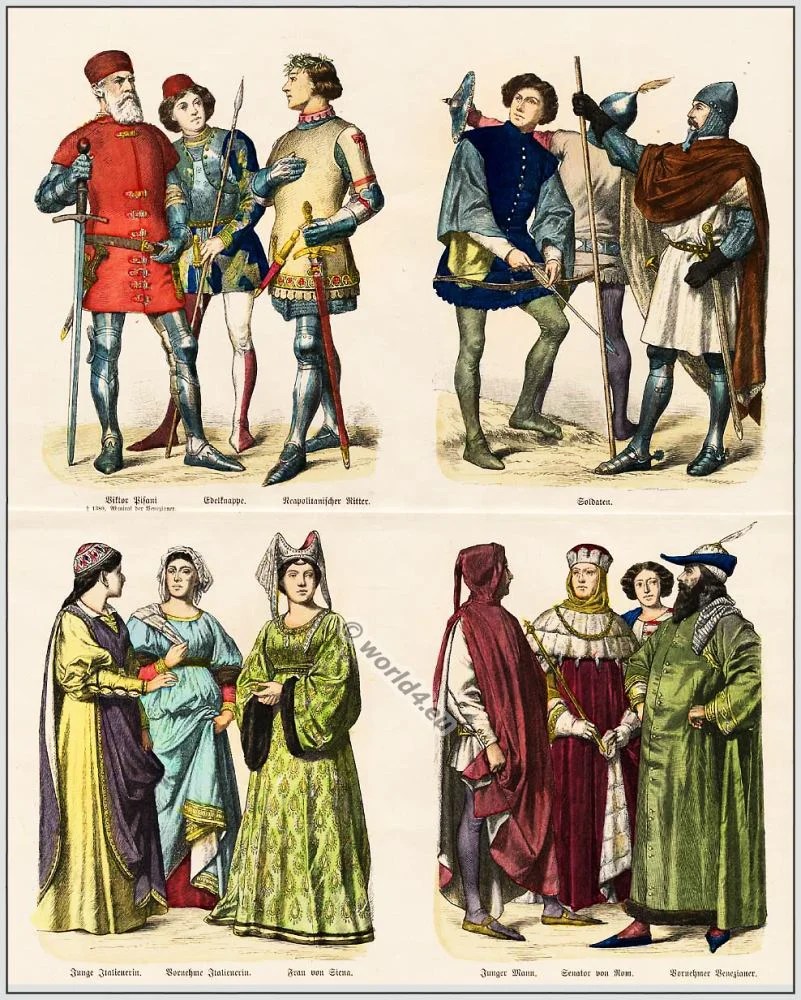
14th century clothing of German nobility. Costume History
The textile and CLOTHING INDUSTRIES together are among Canada's largest manufacturing-sector employers. Total employment averages about 170,700, broken down as follows: textiles, 60,000 and clothing factories, 110,600. Textile-mill shipments average about $6 billion annually. History Records show that as long ago as 1671 pioneer settlers were.

14th century linen smocked apron with pattern. Handsewn
Medieval clothing in the 14th century already saw the emergence of recognizable fashion in clothing, while the use of buttons and lacing enabled easier dressing and undressing as well as more comfortable fitting of clothes. Men's clothes in the 14th century became tighter and shorter. Tunic or shirt previously worn with belt was replaced by.

Pin by Leah Bandy on CoTP 3 Medieval clothing, 14th century clothing
Fashion finally comes to town in the 14th Century. At the start of the century people are wearing what they've been wearing for centuries. By the end of it there are a wide variety of styles people may choose. At the same time, Edward tries to keep everyone in their traditional roles through the Sumptuary Law of 1363.

English medieval fashion in the 14th century. World4
Clothing was layered and these layers were tightly bound to the body. Around this time, the surcoat came into use. By the end of the 14th century, the gown had replaced all garment items aside from the surcoat. Basic garments now consisted of the smock, hose, kirtle, gown, belt, surcoat, girdle, cape, hood, and bonnet.

14th century fashion. Circa 1370. Courtier.
The 14th century is really when fashion began to pick up. The lower classes are beginning to try to imitated the upper classes so to keep some semblance of social order sumptuary laws are passed, dictating which classes can wear what. But then people began to modify their dress to get around the laws, and fashion really begins.

Pin on Medieval
In the fourteenth century, parti-colored clothes became the rage, first with men and then with women. Garments were divided into halves or quarters; each section was sewn from a contrasting color. Shoes and stockings were different colors as well. By the fifteenth century, the surcoat began to disappear.

Early to mid 14th century 14th century clothing, Damsel in this dress
Fashion in fourteenth-century Europe was marked by the beginning of a period of experimentation with different forms of clothing. Costume historian James Laver suggests that the mid-14th century marks the emergence of recognizable "fashion" in clothing, [1] in which Fernand Braudel concurs. [2]

Mid 14th century cotehardie in 2020 14th century clothing, Medieval
Dress - Medieval, Europe, Fashion: The dress of Europeans during the years from the collapse of the western part of the Roman Empire in the 5th century ce to about 1340 was slow to change and was largely standardized over a wide area. Clothes for men and women were similar, being sewn albeit crudely and loosely cut. A shirt or chemise and braies—that is, a roughly fitting kind of drawers.

17 Best images about clothes XIV XV century by Pracownia Rotki on
1400-1500 in European fashion - Wikipedia 1400-1500 in European fashion Full-bodied houppelandes with voluminous sleeves worn with elaborate headdresses are characteristic of the earlier 15th century. Detail from Très Riches Heures du Duc de Berry.

105 best images about 14th Century (1300 1399) England, France, Italy
OVERVIEW The duchy of Burgundy, enriched by the wealth of its Flemish cities, was the leading center of fashion during the 1420s. The Duke of Burgundy's alliance with England supported the production of the finest woolen textiles, woven in Flanders from English yarn.

14th Century Wool Cotte Revival Clothing Company ubicaciondepersonas
The fourteenth century also witnessed some remarkable changes in civilian fashion. During the first quarter of the century, the waist as an individual feature of human anatomy began to be emphasized by the cut of the upper garment, and not by girdle or belt alone as before.

Italian 14th, 15th century fashion history. Costume History
A 14th century CE fashion was the jupon or pourpoint, a tight tunic or jacket with padding. The jupon was fastened by buttons or laces all down the front and there were sometimes buttons running from the elbow to the wrist; sleeves sometimes reached down to the knuckles on these garments. Outer clothes

Vintage engraving of English medieval clothing, 14th Century Stock
OVERVIEW In the first years of the war-torn fifteenth century, fashion was a battleground where rulers and courtiers lay claim to power with the display of luxury textiles, elaborate dagging and fanciful personal emblems. Throughout the decade, the fashions launched at the court of France influenced the rest of Europe.

14th century Surcoat in rich silk brocade, lined in silk, by Prior
It wasn't until the mid-14th century that designs really began to change noticeably, becoming more tailored and increasingly elaborate. It is the style of the nobility in the high Middle Ages that most people would recognize as "medieval clothing." Italian Renaissance Style, 15th- to 17th-Century Italy

14th century dress. Kirtle, European Dress, Century Dress, Chubby
14th-Century Medieval Fashion . The tunics worn by men during the 14th century once again became more form-fitting, and their hemline decreased. The looser styles of tunics continued to be worn by the peasants, while the nobility swapped theirs for the gipon or doublet. The doublet was a knee-length, tightly fitted garment with a low neck and.

3 14th century young nobleman by fengaren 14th century clothing
1869 - Red Silk Dress. In 1860-1869, 19th century, garment analysis. katazome (stencil printing) In 18th century, 19th century, ancient, Asia, K, P, S, term definition. 1905 - André Derain, Lucien Gilbert. In 1900-1909, 20th century, artwork analysis. Inès Gâches-Sarraute and the Straight-Front Corset.